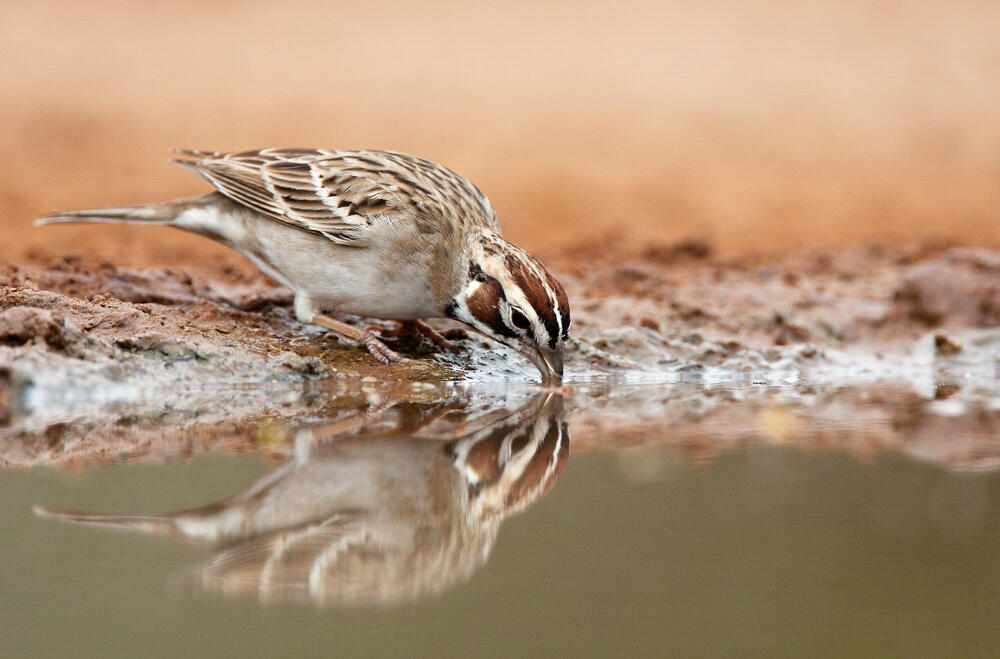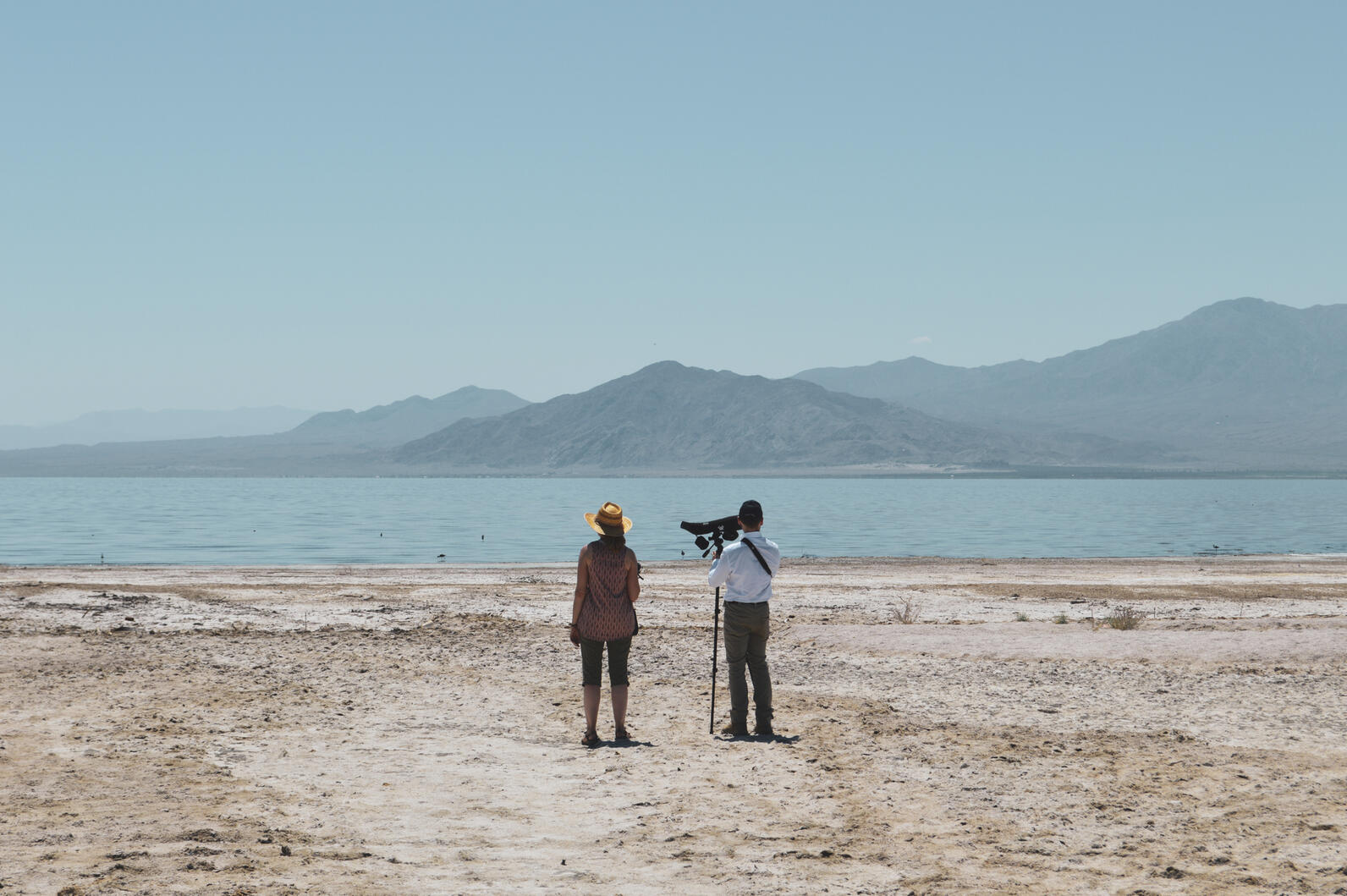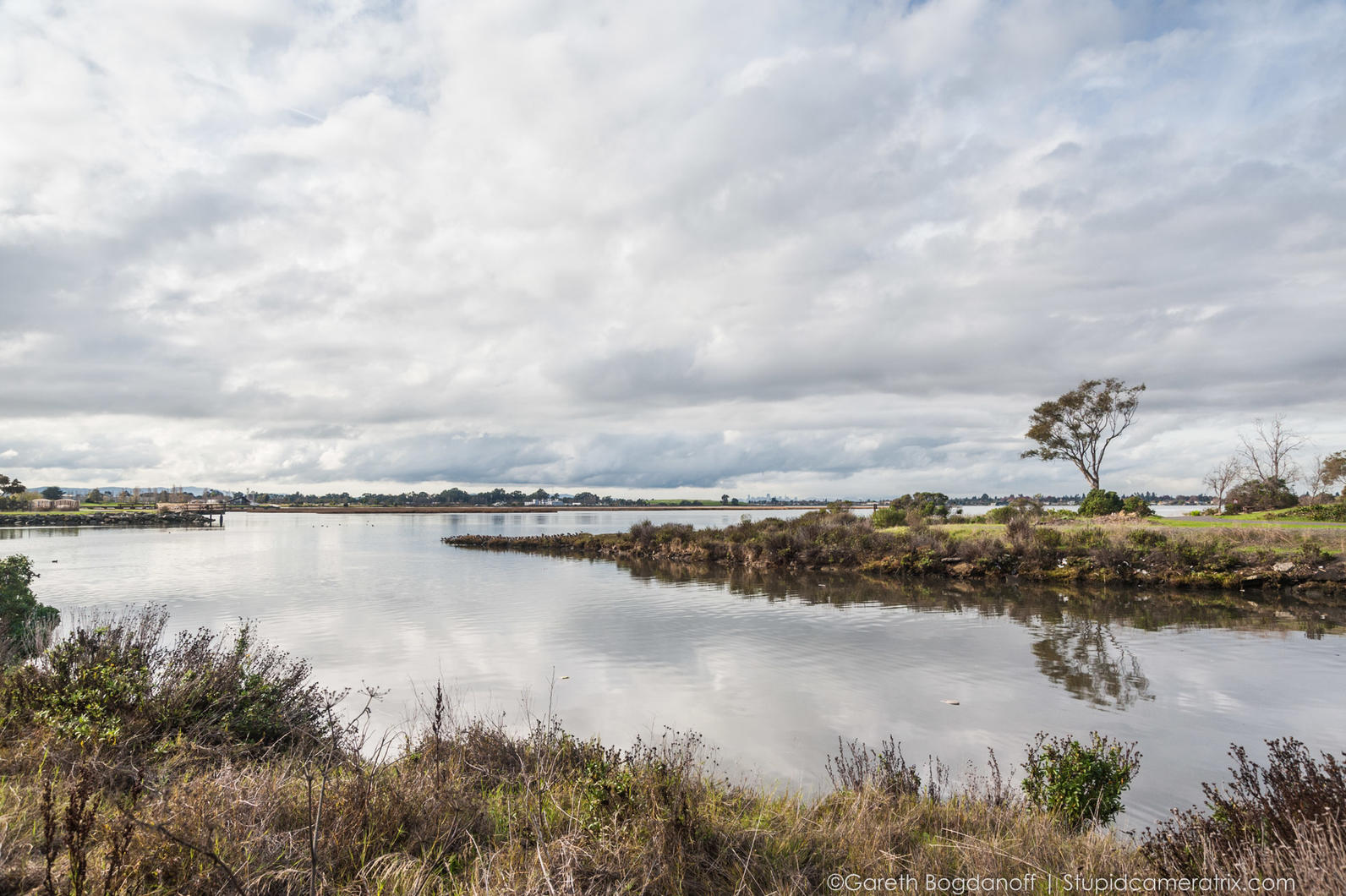Dark-eyed Junco
Latin: Junco hyemalis
From fires in the Sierra to clouds of windblown dust at the Salton Sea, the effects of drought driven by climate change are impo
Peregrine Falcon Photo: Jim Verhagen
California’s Mediterranean climate has the most variable weather of any U.S. state, so it’s no stranger to catastrophic droughts and disastrous floods. Still, even in a drought-prone region, recent years have been exceptional – the result of natural climate cycles colliding with a warming planet. From fires in the Sierra to clouds of windblown dust at the Salton Sea, the effects of drought driven by climate change are impossible to ignore.
The latest science confirms that climate change has arrived and that we are in the middle of a megadrought. In August 2021, a report by the United Nations’ Intergovernmental Panel on Climate Change found that climate change is quickening and intensifying. Even in a best-case scenario, global temperatures will likely rise by 1.5 degrees Celsius by 2040.
In May, 2021, the U.S. Environmental Protection Agency (EPA) declared that the nation has entered uncharted territory in which climate effects are more visible, changing faster and becoming more extreme. Temperatures are rising, snow and rainfall patterns are shifting, and more extreme climate events –like heavier rainstorms and record high temperatures –are already happening. Some, like hotter forest fires, are directly related to historic drought conditions gripping the U.S. West.
The consequences for both California’s avian and human populations are likely to be devastating. Simply put, climate change is the number one threat to the survival of our nation’s birds. In 2019, the National Audubon Society released Survival by Degrees, a study examining the impacts of various climate change scenarios on North America’s birds. Under a worst-case rise of 3.0 C, up to two-thirds of bird species face extinction, including from specific factors like extreme heat and fires. The report came on the heels of another by Cornell’s Lab of Ornithology that the continent has already lost an estimated three billion birds since 1970 due to habitat loss and climate change.
Audubon's Bird and Climate Report

Just 200 years ago, the Central Valley was a vast, seasonal wetland teeming with birdlife. Only about five percent of California’s historic wetlands have survived two hundred years of colonization and intensive agriculture. Those that remain are heavily managed, for the most part receiving water allocations from the state water system together with California’s cities and farms. In addition, some agricultural lands, like flooded rice fields, serve as “surrogate wetlands,” providing vital habitat to migrating waterfowl and wading birds.
However, as of August 2021, the state’s largest reservoirs, Lake Shasta and Lake Oroville, were respectively at 35 and 24 percent of capacity, with proportionate impacts on water deliveries to farms, cities, and wildlife refuges in the Central Valley and elsewhere in California. Our last remaining Central Valley wetlands are expected to receive less than 60 percent of their usual water supply. Winter flooded rice fields, which provide half of the winter waterfowl food supply, are expected to be reduced by 75 percent. The importance of keeping water flowing in the Central Valley is difficult to overstate. Tens of millions of birds depend on the area’s rivers and wetlands as they migrate through an otherwise arid region.
Flooded habitat provided by the region’s farms, refuges, and other managed areas supports between 5-7 million waterfowl and 350,000 shorebirds each year. That’s over 60 percent of the total population along the Pacific Flyway and 20 percent of the nation's waterfowl population. Migrating landbirds also rely heavily on Central Valley stopovers; an estimated 65 million birds pass through during fall migration, along with 48 million each spring. Those numbers include a quarter of all North American Tree Swallows and a whopping 80 percent of Lawrence’s Goldfinches.

Years of fire suppression in western forests and California’s years-long drought have created a trifecta of conditions perfect for explosive wildfires: extreme heat, low humidity, and abundant, desiccated vegetation fire needs to spread. In fact, the state’s worst-ever fires, the 2020’s August Complex Fire at more than a million acres and the 2021 Dixie fire, at more than 960,000, both dwarf all previous fires in both size and ferocity.
The increasingly apocalyptic wildfires of the past five years have cost California dozens of lives and billions of dollars, though the toll on birds is somewhat harder to quantify. While most birds can easily escape advancing flames, extensive wildfires across the western United States in 2020 are suspected at least in part for causing a mysterious die-off of migrating birds in the Southwest. Fire can cause birds to migrate to winter habitats before their bodies have stored enough fat for the arduous journey and thick smoke may disorient some and kill others outright.
While western forests – and their birds – evolved with fire as a natural part of the ecosystem, vital in maintaining diverse habitats, no analog exists for the megafires of the past decade. Experts expect that temperatures in the Sierra will rise by some 10 degrees Fahrenheit over the next century and that the snowpack to melt almost a month earlier. By the end of the century, that could double the acreage burned by wildfires each year.

California’s largest lake is located in one of its most arid regions. The Salton Sea formed in 1905 when an irrigation canal from the Colorado River broke and flooded a historic lakebed. The breach was fixed within a few years, but the Salton Sea, fed by agricultural runoff, remained and became a vital stopover for migrating birds that no longer found wetlands available farther north.
But the Sea is evaporating quickly.
Drip irrigation, and the diversion of the water saved to thirsty San Diego, means that not enough water is flowing to the Sea to maintain it. The retreating shoreline has exposed thousands of acres of playa, or dry lake bed, which contains a century’s worth of agricultural fertilizers, pesticides, heavy metals, and salts. Those contaminants, blown airborne by desert winds, waft towards surrounding towns as choking dust, causing high rates of respiratory illness in some of California’s most disadvantaged communities. Meanwhile, as the surface area of the lake decreases, its salinity increases, killing the fish on which many species of migratory birds depend.
While limited restoration work on the Salton Sea is beginning to proceed – after years of delays – the Sea’s future in a warming climate remains very much in question. Audubon is working with the state of California and partner organizations to maintain the Sea as an asset both for wildlife and for surrounding communities.
While there’s no denying the gravity of the climate crisis, it’s not too late to limit warming and stave off the worst impacts of climate change. With rapid action, we can still limit warming to 1.5 degrees and push lawmakers to enact water policy good for both humans and birds as we all adapt to this warmer, drier new normal.
Audubon and our many partners are working to complete science to better understand how drought impacts birds, we are working with land managers to roll out emergency drought relief funding to create bird habitat, and we are advocating for long-term policy and infrastructure solutions that will make California, our communities and our birds more resilient to this new climate reality.
We are in uncharted territory. Birds are on the move to escape the smoke and stress. What will happen to them and the habitat they need to survive?
Vital protections are needed for wetlands that depend on groundwater under the Sustainable Groundwater Management Act
Audubon science finds that two-thirds of North American birds are at risk of extinction from climate change.
Audubon California has begun the planning phase for the restoration and enhancement of the newly emerging Bombay Beach Wetland, located by the town of Bombay Beach at the Salton Sea.
Funding to address threat to 1.6 million people and 300 species of birds
More than 400 species of birds come to the Salton Sea in California.
As the Environmental Protection Agency signals its intent to roll back fuel standards for new vehicles, California officials are warning that any attempt to restrict its ability to set vehicle emissions standards will be met with fierce legal opposition:
Any decision to revoke California's federal waiver could spur a major legal fight, and the state has already retained former U.S. Atty. Gen. Eric H. Holder Jr. The state will "vigorously participate and defend ourselves" on setting the state's own air quality rules, California Air Resources Board Chair Mary Nichols said.
Automakers reportedly are pressuring the EPA to begin the process of limiting California's ability to set its own standards, which are widely adopted by other states, as well.

News of proposed budget cuts at the Environmental Protection Agency bode ill for conservation in San Francisco Bay and San Diego, as two major programs are on the chopping block.
In San Francisco Bay, the EPA looks to cut its entire $4.8 million budget for clean water and wetlands restoration programs. This is particularly bad news, as San Francisco Bay has never received a proportionate share of federal restoration funding.
Last year, residents of Bay Area communities approved Measure AA, which will raise about $500 million over the next 20 years for wetlands restoration. Leaders had intended to use this money to leverage greater investment from the federal government.
The EPA is also proposing to cut the $3 million it spent last year on cleaning up pollution in the Tijuana Estuary down to $275,000. This area is the last remaining large wetland in Southern California, and is an Important Bird Area. Endangered Ridgeways Rails and Light-footed Rails make great use of the area.
In addition to cuts specifically targeting California, we also learned of proposed cuts that will go into effect nationwide, but will certainly impact things we Californians care about, such as gutting programs that test coastal water quality, educate our children about nature, address climate change, and reduce pollution in communities suffering the most.
Please raise your voice against these cuts by sending an email to your members of Congress.
Fascinating piece on NPR about the demand from some Southern California communities that their air pollution problems be addressed alongside climate change policies.

Already on a fast-track to building a reliable renewable energy infrastructure, California may soon set its sights on a future that is totally fossil fuel-free. Last week, right at the deadline for new bills, California State Senate President pro tem Kevin De León introduced legislation that will hasten the state's shift to renewable energy. Senate Bill 584 will push up California's shift to 50% renewables by 2025 (five years sooner than our current goals) and 100% by 2045.
We've talked about this before, but pumping from aquifers under the San Joaquin Valley is continuing to cause the valley floor to sink significantly:
Ground levels in some areas have dropped 1 to 2 feet in the last two years, creating deeper and wider “bowls” that continue to threaten the vital network of channels that transport water across Southern California, researchers say.
The findings underscore the fact that even as record rain and snow have brought much of California out of severe drought, some parts of the state will probably struggle with water problems for years to come.
Great article in the Los Angeles Times about how recent rains have brought the struggling Yolo Bypass near Sacramento back to life.
This is going to be a make-or-break year for the Salton Sea, as state officials attempt to figure out how to deal with the effects of wtaer diversions expected to kick in beginning in 2018. This is expected to have major implications not only for bird habitat, but for the hundreds of thousands of people who live in the area. Andrea Jones recently visited the Salton Sea to talk about the current situation, and what Audubon California is doing to help. Learn more about our work at the Salton Sea.
Our newsletter is fun way to get our latest stories and important conservation updates from across the state.
Help secure the future for birds at risk from climate change, habitat loss and other threats. Your support will power our science, education, advocacy and on-the-ground conservation efforts.
Join the thousands of Californians that support the proposed Chuckwalla National Monument.
Our newsletter is fun way to get our latest stories and important conservation updates from across the state.
Help secure the future for birds at risk from climate change, habitat loss and other threats. Your support will power our science, education, advocacy and on-the-ground conservation efforts.
Join the thousands of Californians that support the proposed Chuckwalla National Monument.